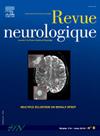法国纳塔利珠单抗(TYSABRI®)治疗的活动性复发-缓解型多发性硬化症患者的现实世界管理趋势:PMSI数据库5年(2019-2023)的分析。
IF 2.3
4区 医学
Q2 CLINICAL NEUROLOGY
引用次数: 0
摘要
一些因素正在改变目前使用纳他珠单抗(NTZ)治疗复发-缓解型多发性硬化症(RRMS)的方式,包括在家庭住院结构中越来越多地使用注射,治疗配方的改变,怀孕时的使用策略,有时延长间隔给药(EID)以降低不良事件(ae)的风险,特别是进行性多灶性白质脑病(PML)。目的:描述2019-2023年期间法国接受natalizumab治疗的多发性硬化症(PwMS)患者的现实管理变化。方法:这是一项回顾性观察性研究,使用了2019年1月1日至2023年12月31日从法国国家医院数据库(PMSI)中提取的数据,包括NTZ的所有报销数据:患者的人口统计学特征、分娩和输液日期、药物配方、使用的设施类型(急性护理、家庭住院)和最终怀孕。结果:2019年共发现5708例NTZ患者,2023年增加到7181例。在此期间,年龄/性别分布稳定,女性占76.9%,平均年龄为39.9岁(SD 11.40)。家庭注射次数从2019年的6次大幅增加到2023年的3501次,特别是在COVID-19医疗机构重组之后。自2021年12月推出NTZ皮下(SC)制剂以来,静脉输注比例从2022年1月的71.0%下降到2023年12月的29.2%。在整个5年期间,在36-42天期间使用NTZ的频率从2019年的5.9%增加到2023年的17.0%。自从分娩的患者人数从2019年的117人增加到2023年的179人以来,关于NTZ和怀孕的做法发生了变化。2019年,近20%的患者在受孕前三个月内停止了NTZ,而从2020年起,只有7%至8%的患者停止了NTZ。在2019-2023年期间,妊娠前三个月和妊娠中期NTZ的维护率明显从75%增加到90%,妊娠中期从44%增加到近78%。结论:在2019-2023年期间,尽管丰富了用于PwMS的治疗武器库,但Natalizumab的使用在法国保持甚至增加。当然,随着家庭注射的发展,更好的治疗管理,SC配方的简化程序,静脉注射配方每5-6周进行一次EID的可能性以及怀孕时更好地使用,都促进了这一点。本文章由计算机程序翻译,如有差异,请以英文原文为准。
Trends in the real-world management of patients with active relapsing-remitting multiple sclerosis treated with natalizumab (TYSABRI®) in France: An analysis of the PMSI database over five years (2019–2023)
Several factors are changing the way relapsing-remitting multiple sclerosis (RRMS) is currently managed with natalizumab (NTZ), with increasing use of injections in home hospitalization structures, change in treatment formulation, strategy of use regarding pregnancies and sometimes extending interval dosing (EID) to reduce the risk of adverse events (AEs), notably progressive multifocal leukoencephalopathy (PML).
Objective
To describe changes in the real-world management of people with multiple sclerosis (PwMS) treated with natalizumab in France over the period 2019–2023.
Methods
This is a retrospective observational study using data extracted from the French national hospital database (PMSI) from the first of January 2019 to the 31st of December 2023 including data on all reimbursements of NTZ: patients’ demographic characteristics, dates of deliveries and of infusions, formulation of the drug, type of facilities used (acute care, home hospitalization) and eventual pregnancies.
Results
A total number of 5,708 patients treated with NTZ were identified in 2019, increasing to 7,181 in 2023. The age/gender distribution was stable over the period with 76.9% of women and a mean age of 39.9 years (SD 11.40). The number of at home injections increased substantially from 6 in 2019 to 3,501 in 2023, particularly after COVID-19 health care reorganization. Since December 2021, when the NTZ subcutaneous (SC) formulation was launched, the percentage of intravenous infusions decreased from 71.0% in January 2022 to 29.2% in December 2023. Over the whole 5-year period, frequency of using NTZ with EID between 36–42 days increased from 5.9% in 2019 to 17.0% in 2023. Practices changed regarding NTZ and pregnancies since the number of patients with a delivery increased from 117 in 2019 to 179 in 2023. NTZ was stopped in nearly 20% of patients during the three months before conception in 2019 and 7–8% only from 2020. Maintenance of NTZ during the first as well as the second trimester of pregnancy clearly increased over the 2019–2023 period from 75% to 90% in the first trimester and 44% to nearly 78% in the second trimester.
Conclusion
Natalizumab use was maintained and even increased in France over the 2019–2023 period despite enrichment of the therapeutic arsenal for PwMS. It was certainly facilitated by better therapeutic management with the development of at-home injections, simplification of the procedure with the SC formulation, the possibility of EID every 5–6 weeks for the intravenous formulation and better use regarding pregnancies.
求助全文
通过发布文献求助,成功后即可免费获取论文全文。
去求助
来源期刊

Revue neurologique
医学-临床神经学
CiteScore
4.80
自引率
0.00%
发文量
598
审稿时长
55 days
期刊介绍:
The first issue of the Revue Neurologique, featuring an original article by Jean-Martin Charcot, was published on February 28th, 1893. Six years later, the French Society of Neurology (SFN) adopted this journal as its official publication in the year of its foundation, 1899.
The Revue Neurologique was published throughout the 20th century without interruption and is indexed in all international databases (including Current Contents, Pubmed, Scopus). Ten annual issues provide original peer-reviewed clinical and research articles, and review articles giving up-to-date insights in all areas of neurology. The Revue Neurologique also publishes guidelines and recommendations.
The Revue Neurologique publishes original articles, brief reports, general reviews, editorials, and letters to the editor as well as correspondence concerning articles previously published in the journal in the correspondence column.
 求助内容:
求助内容: 应助结果提醒方式:
应助结果提醒方式:


